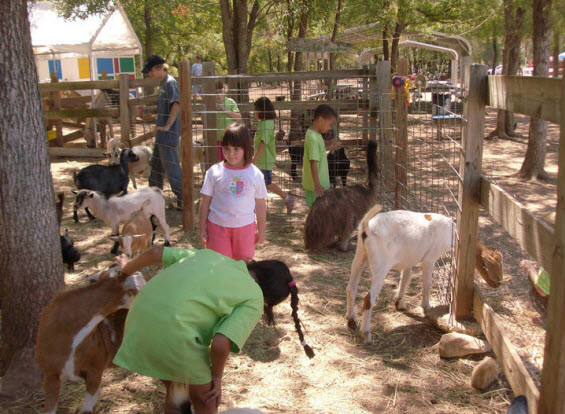 We’re fully into petting zoo season now, with these types of exhibits appearing at a variety of agricultural fairs and similar events. This also unfortunately means that we’re into petting zoo outbreak season, since there’s always some risk of disease associated with the type of animal contact people have at these displays. There are some basic measures that can and should be taken to reduce the risk of disease transmission, including proper facility design, selection of appropriate animals, good animal health monitoring, sufficient supervision, and above all, providing adequate hand hygiene facilities. Unfortunately, these measures aren’t always implemented – even the really easy ones – be it due to lack of knowledge, lack of interest or downright negligence.
We’re fully into petting zoo season now, with these types of exhibits appearing at a variety of agricultural fairs and similar events. This also unfortunately means that we’re into petting zoo outbreak season, since there’s always some risk of disease associated with the type of animal contact people have at these displays. There are some basic measures that can and should be taken to reduce the risk of disease transmission, including proper facility design, selection of appropriate animals, good animal health monitoring, sufficient supervision, and above all, providing adequate hand hygiene facilities. Unfortunately, these measures aren’t always implemented – even the really easy ones – be it due to lack of knowledge, lack of interest or downright negligence.
A recent study in Zoonoses and Public Health (Erdozain et al. 2012)(completed under the guidance of Doug Powell and Ben Chapman of BarfBlog fame… or infamy, if you’re a particularly slack regulator or politician) evaluated some important public health-related behaviours and factors at petting zoos in Kansas and Missouri in 2010-2011. They found:
- Handwashing stations and signs were present at the exit of 7/13 petting zoos. Yes, it means the majority had them, but it’s a pretty disappointing number. Providing proper hand hygiene stations is easy to do and there’s no excuse for not having them at the exit. The other 6 petting zoos at least had hand hygiene stations within or near animal contact areas, but that’s not ideal. People need to be able to clean their hands on the way out. Doing it in the middle doesn’t help much, and if people have to go out of their way to perform hand hygiene after leaving, it will rarely get done.
- At one event, there was only a sink with no soap, and at another, 2/3 hand sanitizer bottles were empty and there was no area to wash hands. Having hand hygiene facilities is only useful if they are actually appropriately stocked.
- Signs encouraging hand washing were present at the exit of 10/13 petting zoos, but no signs were present at the entrance or entrance to eating areas at any of the venues.
- There were staff monitoring activities at only 6/13 events. At one unsupervised facility, kid goats were able to escape through the fence and were roaming freely.
- When the researchers observed zoo visitors, they noted that only 37% of individuals washed their hands or used a hand sanitizer when leaving. That’s not really surprising, but it’s disappointing nonetheless. People are skipping the best and easiest way to mitigate what is typically the biggest risk factor for pathogen transmission in petting zoos (i.e. contamination of hands ultimately leading to ingestion of pathogens).
- Visitors were almost 5 times as likely to wash their hands when a staff member was present. That’s consistent with a study we published last year and shows the importance of a little encouragement.
- High-risk animals were present in some petting zoos. These included chicks, young ruminants (kid goats) and (a new one for me) a petting zoo that allowed people to enter an area and pet and sit with tortoises.
- People were allowed into animal enclosures in 7 petting zoos, and not surprising, fecal contamination of the ground was common (petting zoo animals not being house trained).
- Various behaviours that might increase the risk of disease transmission were observed, including kids (the human kind, not the goat kind) touching their faces (77% of events), kids eating or drinking in the petting zoo (15% and 38%, respectively), kids eating petting zoo food (7%) and kids sucking on pacifiers (23%). Children were also seen picking up animal feces at one event.
Overall, despite the lessons that should have been learned from various past outbreaks, numerous deficiencies were present, including many that would take little effort to rectify.
The state of petting zoos, at least around here, has certainly improved over the past decade, in part due to more attention from local public health officials, but how do we get more, sustained and widespread improvement?
More strict governmental regulation and enforcement is one way, but that tends to be slow. The more effective approach is probably one that involves the almighty dollar. Most petting zoos are there to make money or bring people to a bigger event that makes money. Like many issues, if consumers start demanding change, change will occur quickly. Maybe that’s easier said than done, but the more pressure that’s put on petting zoo operators and people who run events where petting zoos are present, the more likely it is that change will occur. Visiting a petting zoo can be a great experience, particularly for kids, but we need to make them as safe as possible. Providing hand hygiene stations, some appropriate well-placed signs, having staff supervise, avoiding high-risk animals and logical facility design are easy and inexpensive, and not employing such simple measures is inexcusable.